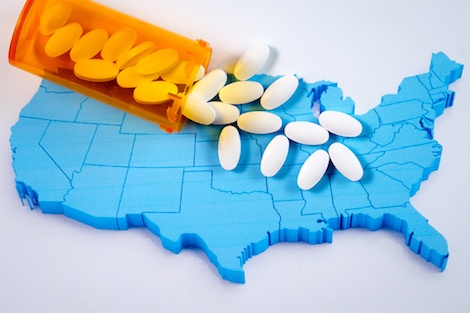
Boston, MA –(ENEWSPF)—July 23, 2018
Contact: Chris Sweeney
Congressional districts with the highest opioid prescribing rates are predominantly concentrated in the southeastern U.S., with other hotspots in Appalachia and the rural west, according to a new study led by Harvard T.H. Chan School of Public Health. The study, the first to focus on opioid prescribing rates at the congressional district level, could help policy makers at the federal and state level better target intervention and prevention strategies.
The study was published online July 19, 2018 in American Journal of Public Health.
“It is important for public health research to focus on geographical units such as congressional districts as it allows for elected representatives to be more informed about important issues such as the opioid epidemic. Because a congressional district has a named elected representative, unlike say a county, it brings a certain degree of political accountability when it comes to discussing the opioid epidemic,” said S V Subramanian, professor of population health and geography.
The study found that Alabama’s Fourth Congressional District had 166 opioid prescriptions per 100 people, the highest rate of any district in the nation. Districts in Kentucky, Tennessee, Mississippi, Arkansas, Virginia, and Oklahoma rounded out the top ten areas with the highest prescribing rates. Other high prescribing rates were found in districts located in eastern Arizona, Nevada, northern California, rural Oregon, and rural Washington.
The lowest opioid prescribing rates tended to be concentrated in congressional districts near urban centers, including Washington, D.C., New York, Boston, Atlanta, Los Angeles, and San Francisco. Virginia was the only state that had congressional districts with top- and bottom-ten opioid prescribing rates.
The findings come amid a national opioid epidemic that has claimed tens of thousands of lives. Between 1999 and 2010, prescription opioid-related overdose deaths quadrupled, according to the U.S. Centers for Disease Control and Prevention, and the epidemic was estimated to cost $78.5 billion in 2013—one-third of which was spent on health care and treatment costs. In 2016 overdoses resulted in more than 42,000 deaths, and the following year President Trump officially declared a public health emergency.
“A great deal of variation may exist between state-level opioid prescribing rates and prescribing rates in specific congressional districts within the state,” said Lyndsey Rolheiser, a postdoctoral research fellow and lead author of the paper. “Having these data could help representatives advocate more strongly for federal policies aimed at curbing the opioid epidemic and helping their constituents.”
Other Harvard Chan researchers who contributed to this work included Jack Cordes, a master’s student in epidemiology.
“Opioid Prescribing Rates by Congressional Districts, United States, 2016,” Lyndsey A. Rolheiser, Jack Cordes, and S V Subramanian, American Journal of Public Health, online July 19, 2018, doi: 10.2105/AJPH.2018.304532
Visit the Harvard Chan School website for the latest news, press releases, and multimedia offerings.
###
Harvard T.H. Chan School of Public Health brings together dedicated experts from many disciplines to educate new generations of global health leaders and produce powerful ideas that improve the lives and health of people everywhere. As a community of leading scientists, educators, and students, we work together to take innovative ideas from the laboratory to people’s lives—not only making scientific breakthroughs, but also working to change individual behaviors, public policies, and health care practices. Each year, more than 400 faculty members at Harvard Chan School teach 1,000-plus full-time students from around the world and train thousands more through online and executive education courses. Founded in 1913 as the Harvard-MIT School of Health Officers, the School is recognized as America’s oldest professional training program in public health.
Source: www.harvard.edu








